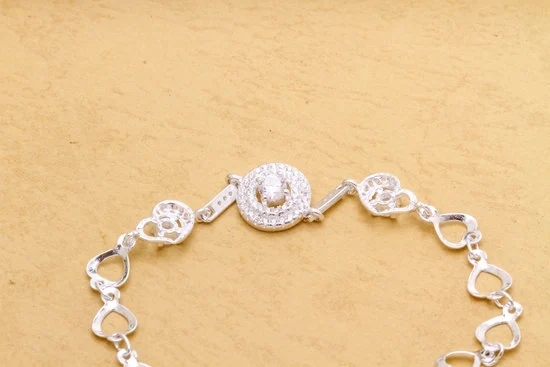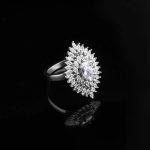The current trends in the jewelry industry have become increasingly focused on sustainability and eco-friendly practices. Consumers are becoming more aware of their impact on the environment, and as such, many want to invest in jewelry that does not do further harm.
As people become more conscious about what goes into their jewelry, both ethically and environmentally, they prioritize pieces made by companies with ethical sourcing standards. There has been an upsurge in awareness of “conflict diamonds” or “blood diamonds” – diamonds mined illegally and then sold to fund wars – as well as a desire for jewels sourced from mines operated safely and ethically.
When shopping for sustainable jewelry options, consumers should consider the source of the materials used to create the item. Precious metals can be recycled, so it is important to look for pieces which use recycled metal for their constructions. It is also smart to inquire about where stones were sourced from; if possible, opt for gems that are certified responsibly mined by a reliable source, like GIA (Gemological Institute of America).
In addition to being sustainably created, it is important that jewelry makers aim to be transparent about how they source their materials. They should clearly communicate how and where they make their products so that customers can make informed decisions.
The majority of fashion stores offer some variety of sustainable jewelry options; however local artisan markets often feature goods made with eco-friendly practices. Making a point of seeking out these fair trade or independent retailers will ensure patrons are able to buy directly from creators who work in ethical settings using sustainable resources.
Supporting small businesses helps keep dollars within the local community while contributing to a much larger movement towards sustainability within the fashion industry at large. People who take part in this initiative will ultimately help protect environment with their purchases of quality pieces made with respect for its surrounding life forms.
Incorporating Influencers into Jewelry Trend Marketing Strategies
The jewelry industry has seen an exponential increase in demand with the rise of influencers. Influencers are celebrity figures on Instagram, YouTube, and other social media platforms who promote products to their audience. By utilizing influencers in marketing campaigns, companies have been able to reach a vast audience and create hype around their products or services. This has played a major role in driving consumer trends within the jewelry industry.
Social media marketing has proven highly successful for companies selling jewelry as it allows them to reach a much wider demographic than traditional forms of advertising. Besides leveraging well-known influencers to promote their products, companies have also begun reaching out to lesser-known micro-influencers who have amassed small but devoted followings on various platforms. These smaller influencers have an emotional connection with their followers that resonates well with brands seeking to do more authentic advertising.
In terms of product design, there is an overarching trend toward minimalism across all fashion industries and jewelry makers are no exception. Millennials, in particular, prefer simple designs with minimal embellishments as they want items that can seamlessly fit in with any ensemble without dominating it aesthetically.
Jewelry trendsetting is also moving more towards custom pieces that are tailored specifically for customers and contain engravings or secret charms that add personal touches and make them feel special when wearing the creation.
Highlighting Trends for Different Types of Jewelry
The jewelry industry is constantly changing and evolving as fashion trends come in and out of style, from statement necklaces to layered earrings. In recent years, there has been a spike in demand for specific types of jewelry that are designed with convenience and versatility at the heart. These are the current trends in the jewelry industry that have caught on quickly among the modern consumer.
One type of jewelry that has taken off recently is stackable rings. As people often coordinate their pieces of jewelry, stackable rings provide endless ways to curate your own unique combination look.
Whether you’re looking for more subtle, complementary colors or using standout colors like reds and greens to make a louder statement – combining them creates a visually stunning look. Stackable rings also work great when pairing with other pieces of jewelry such as bracelets and necklaces, as they provide extra depth and texture to accessorize any outfit.
Charm necklaces also appear to be having quite a moment right now due to their ability to invoke meaningful connections with significant symbols behind them. They come in all different shapes, sizes, and colors; this makes it easy for anyone to find charm necklaces that best represent themselves or those they love. The charms further enhance this sentimentality factor by providing personalization opportunities; simply affixing an additional charm brings unlimited possibilities to capture feelings through words or symbols.
Lastly, we can’t ignore the trend that has emerged over recent years – bamboo hoop earrings. Lightweight yet chic in style, bamboo hoop earrings are both fashionable and practical due to their bold design which can be dressed up or down depending on what look you’re striving for. The unique shape provides edge against standard hoop earrings which is why this style has become so popular amongst fashion influencers alike over the past few seasons.
Overall, regardless of what type of jewelry pieces you prefer – whether classic gold pendants or chunky geometrical shapes – choosing one based on its customization opportunities allows us all to own something truly special that we won’t find anywhere else.
Knowing what’s trending within the industry empowers us to make better decisions when selecting new additions for our collections – ultimately allowing us to express our true individual styles through whatever designs speak most closely with our values or stories we want to tell.
Discussing Industry-Wide Jewelry Crafting Techniques
The jewelry industry is constantly growing and expanding, with stylish trends and modern techniques that change the way jewelry is crafted and presented. A few of the current trends that are being utilized in the industry range from using traditional metals such as gold, silver and platinum, to also including alternative materials like wood, resin and clay.
With these new materials, craftspeople have been able to get creative with their artwork to create a variety of stunning pieces. Additionally, many stores now carry an array of vintage jewelry, as customers look for unique pieces with a touch of charm and elegance.
A major key factor in how jewelry is crafted today has been the rise of technology. Laser welding tools have enabled crafters to create intricate designs composed of more than one metal type at a time. This has allowed for unprecedented levels of detail which would be impossible when using manual crafting methods. These designs can easily be replicated on both finemetal and alternative material selections, therefore providing a greater range of options for designing high-quality jewelry pieces.
Furthermore, manufacturers have also taken advantage of 3D printing capabilities in order to produce notable designs that could not have been conceived without this method. For example detailed tension settings where diamonds or gemstones appear suspended between two plates have become somewhat common nowadays due to this technology which was also used for recreating historical patterns by CAD designers who capture elaborate shapes which would otherwise be difficult to achieve through conventional casting processes.
Overall these trends indicate that the industry will continue to modernize jewelry crafting techniques in order to present individuals with beautiful pieces they can appreciate over time.
Exploring Non-Traditional Uses for Jewelry
The jewelry industry has evolved in many ways over the years. One particular area of advancement is the exploration of non-traditional uses for jewelry. Consumers are beginning to seek out pieces that can be used as everyday objects such as key rings, functional pins, and unique photo frames. As a result, modern jewelry features more design versatility which enables customers to find creative ways to add an extra flair to their homes and look.
Functionality is becoming increasingly important in the design process when creating pieces for sale. Not only are buyers looking for products that express their individuality and style, they also expect them to be able to perform multiple tasks besides just decorating their attire or being displayed as showpieces at home.
For instance, racks created from metal bangles are capable of holding coats and garments or several small earrings can be used as hooks to hang up accessories like necklaces and handbags.
Additionally, modern jewelry is designed and produced using eco-friendly materials such as bamboo wood and recycled metals. Additionally, handmade items are highly sought after since they cast fewer carbon emissions into the environment compared to mass-produced units made with mechanical processes. This approach ensures that buyers have access to sophisticated pieces without contributing too much toxicity into nature’s complex systems.
Ultimately, current trends in the industry translate into more aesthetically pleasing designs with practical use applications in everyday scenarios all while respecting our environment’s balance of natural materials we all depend on ultimately More emphasis is placed on achieving creative combinations where form meets function with eco-friendly production techniques driving innovation forward every day.
Comparing and Contrasting Available Materials
The jewelry industry has seen a dramatic transformation in recent years, with many new trends and innovative materials being used. Of the most popular of these materials are diamonds, gold and silver. Each material has its own unique characteristics and there is much to consider when making a jewelry purchase decision.
As far as diamond jewelry is concerned, this is often considered the premier choice for various occasions or for special gifts. Diamonds are extremely hard and impervious to scratches and dirt, meaning that any piece of diamond jewelry will be highly durable and should remain beautiful for generations if cared for properly. Of course, the price of diamonds can be quite costly, so it is important to ensure that you’re getting value for your money.
Gold jewelry also remains popular today and often utilized when seeking something more timeless or classic in style. Gold provides an almost universal appeal and accepts numerous settings that show off both white gold as well as yellow gold pieces beautifully. One thing to note about gold however is that it tends to be softer than diamonds so need more care when handling your piece of jewelry to ensure it stays looking its best over the years.
Finally, silver jewelry continues to maintain popularity due its flexibility both in terms of design possibilities but also pricing. When looking at traditional silver options such as sterling silver which features 92% silver with 8% other elements good quality pieces will still command a premium compared to finds from less regulated markets where lower quality outputs have meant less dedicated attention from craftspeople on their workmanship which delivers a slightly different result sometimes undesirable ones like tarnishing.
With advancements made with some current day alloys including titanium nickel steels even retain their shine longer metal colors have become increasingly viable than traditionally thought possible. Thereby creating noticeably different looks ranging from soft easy light grey shades mild copper tones even difficult look glossy black or bright colors like blue green & red allowing metal options even without diamonds bling factor left behind.
Examining Historical Trends in Jewelry
The jewelry industry has seen its fair share of changes and trends throughout history depending on the cultural contexts and available technology. The use of jewelry dates back as far as 25,000 BC, with some archeologists finding evidence of ancient necklaces made out of shells or animal bones that were found in West Asia. Jewelry was primarily used for symbolic purposes back then to mark one’s status and wealth.
During the Egyptian Dynasties, the jewelry industry saw a shift from the wearing of organic materials to metals such as silver and gold, showing once again how strongly people associated jewelry-wearing with social class. Throughout history, almost every culture has had their own version of traditional jewelry styles that usually entirely depend on the resources available to them at any given time.
The most recent trend in jewelry can be seen in terms of digitalization. 3D printing has allowed designers to take creativity to whole new levels when it comes to making creative products due to its ability to fabricate intricate pieces with very small parts.
This is causing an enormous rise in demand for customized jewelry pieces that many consumers are now able to make themselves with 3D modeling software and machines like CNC (computer numerically controlled machines). Your favorite materials such as metal and stone can now be formed into complex shapes which would have been impossible before.
Another modern trend is seen in terms of sustainability as much more focus is being put towards eco-friendly materials and practices amongst jewelers today. Many online stores are using reclaimed wood for making stylish wooden products after treating them thoroughly first, or recycled plastic for making attractive bangles or earrings for instance – both these methods reduce the amount of waste generated from jewelery production significantly compared to previous generations’.
Some have even stumbled upon ways to turn human hair into precious accessories. Ultimately, this novel approach seeks goals towards reducing emission rates in order for us all to live a little greener than before.
Investigating Trends in Jewelry Pricing
The jewelry industry is ever-evolving, with new styles and trends emerging to meet customer demand. One particular current trend in the jewelry industry that buyers should be aware of is the trend in pricing. Jewelers are carefully mapping out strategies for their price points, as customers rely on both price and quality when deciding which pieces to purchase.
High-end market prices are typically far higher than consumer-grade prices. This can be attributed to a variety of factors such as the use of precious materials, craftsmanship and detail that goes into making a piece. For example, a high-end gold necklace may contain exquisite diamonds etched in intricate designs.
Companies have also become more prestigious by creating limited-edition collections that contain one-of-a-kind designs that cannot be duplicated or bought anywhere else, ensuring that these items remain exclusive and valuable. Furthermore, with luxury collections being released continuously by many different companies, customers have several options when it comes to selecting what they deem most valuable for them.
In contrast, budget market prices are primarily based on inexpensive materials such as cubic zirconia stones or acrylic beads rather than real pearls or gems; which allows the designers to provide items at greatly reduced prices while maintaining acceptable quality standards in terms of durability and aesthetics. Additionally, with technological advancements taking place rapidly within this sector, more affordable options have been made available to meet customer needs at lower cost points thus providing more options for all budgets.
Another area where cost savings can be seen is through the rise of popular customizable jewelry solutions such as engraving technology, simply allowing anyone to personalize any piece exactly how they desire it at minimal costs – typically only for a small fee which further contributes to making these pieces desirable but still affordable for the masses.
By understanding current trends in pricing within the jewelry industry, consumers can confidently make wise purchases knowing that they’ve invested in pieces tailored perfectly to fit their own specific style and desired budget without having to sacrifice an ounce of creativity or quality accompanying any choice made.
Suggesting Ideas for What’s to Come in the Jewelry Industry
The jewelry industry has seen drastic changes in recent years as consumer tastes and preferences continue to evolve. This is most evident by the current trends that have resulted from consumer desires for self-expression, personal gratification, investments, and accessorizing. What can we expect from this ever-changing industry in the coming years? Here are some ideas on what may be the future of jewelry:
One idea is the growth of sustainable and eco-friendly materials within the industry. Many consumers have become increasingly aware of their environmental footprint and are looking for brands that make use of recycled materials or natural resources when creating their pieces.
For example, companies like Amorium are using upcycled glass beads made from beer bottles collected in Africa or planet-friendly sterling silver mined from a responsible source to create pieces that thousands of customers love and feel proud to wear without compromising their values.
Another trend we could see is the influx of NFTs – also known as “Non-Fungible Tokens” – into jewelry designs. NFTs are digital tokens designed to represent digital assets like artworks or game items.
By creating one-of-a-kind pieces available only through NFTs, jewelers would provide people with an opportunity to invest into luxury goods in a way they have never been able to before. This trend could cause a major disruption in how consumers interact with the luxury jewelry market, providing more options when thinking about buying precious metals or gemstones jewelry pieces as investments.
The third trend that seems likely to enter mainstream usage is customization. Consumers will want more control over how jewelry looks from an aesthetic standpoint; paving way for innovative technology such as 3D printing, allowing individuals to design their own unique pieces according to their own tastes and style preferences.
Combined with ethical sourcing practices, 3D printing enables fast delivery times using fewer resources than traditional methods, resulting in pieces tailored exactly to one’s taste and liking without long lead times or excessive costs associated with high-end manufacturing methods typically used for franchised brands today.

Welcome to my jewelry blog! My name is Sarah and I am the owner of this blog.
I love making jewelry and sharing my creations with others.
So whether you’re someone who loves wearing jewelry yourself or simply enjoys learning about it, be sure to check out my blog for insightful posts on everything related to this exciting topic!





